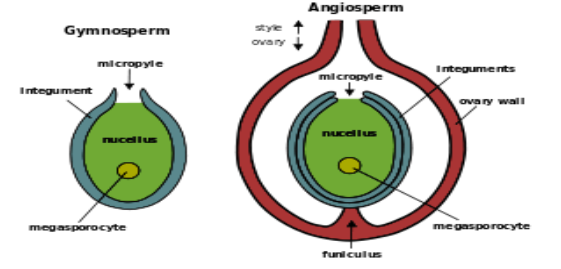
Draw the structure of ovule and label its parts.
Answer
561.3k+ views
Hint:Ovule is a part of flowering plants that is located inside the gynoecium which is most commonly known as the female part of the flower. Ovules are found to be attached to the placenta in the ovary through a stalk like structure. Ovules develop into seeds post fertilization.
Complete answer:
The ovule is known to be consisting of three parts which are- integument, nucellus and female gametophyte. Integument is defined as a protective layer of cells that surround the ovule. The structure of ovules is found to be different in gymnosperms and angiosperms. These integuments finally develop into seed coats when the ovule matures following fertilization. Gymnosperms mostly have one integument whereas angiosperms have two integuments. The nucleus is located inside the integument and is both structurally and functionally similar to the megasporangium. The nucellus develops into perisperm after fertilization that provides food to the developing embryo. The female gametophyte which is also known as the megagametophyte which is known to develop from the megaspore through mitotic division. The megagametophyte forms the egg cell that undergoes fertilization to produce the zygote. The structure of the ovule along with its part are given in the diagram below.

Note:Ovules are important structures of plants as it is involved in the process of fertilization that finally forms the offspring. So a knowledge about the ovule and its different parts help us to understand its role in fertilization in a better way.
Complete answer:
The ovule is known to be consisting of three parts which are- integument, nucellus and female gametophyte. Integument is defined as a protective layer of cells that surround the ovule. The structure of ovules is found to be different in gymnosperms and angiosperms. These integuments finally develop into seed coats when the ovule matures following fertilization. Gymnosperms mostly have one integument whereas angiosperms have two integuments. The nucleus is located inside the integument and is both structurally and functionally similar to the megasporangium. The nucellus develops into perisperm after fertilization that provides food to the developing embryo. The female gametophyte which is also known as the megagametophyte which is known to develop from the megaspore through mitotic division. The megagametophyte forms the egg cell that undergoes fertilization to produce the zygote. The structure of the ovule along with its part are given in the diagram below.

Note:Ovules are important structures of plants as it is involved in the process of fertilization that finally forms the offspring. So a knowledge about the ovule and its different parts help us to understand its role in fertilization in a better way.
Recently Updated Pages
Master Class 12 Business Studies: Engaging Questions & Answers for Success

Master Class 12 Economics: Engaging Questions & Answers for Success

Master Class 12 English: Engaging Questions & Answers for Success

Master Class 12 Maths: Engaging Questions & Answers for Success

Master Class 12 Social Science: Engaging Questions & Answers for Success

Master Class 12 Chemistry: Engaging Questions & Answers for Success

Trending doubts
December 10th of 1948 is an important day in the history class 12 sst CBSE

Prove that a parallelogram circumscribing a circle-class-12-maths-CBSE

Dihybrid cross is made between RRYY yellow round seed class 12 biology CBSE

The correct structure of ethylenediaminetetraacetic class 12 chemistry CBSE

What is the Full Form of PVC, PET, HDPE, LDPE, PP and PS ?

The first microscope was invented by A Leeuwenhoek class 12 biology CBSE




